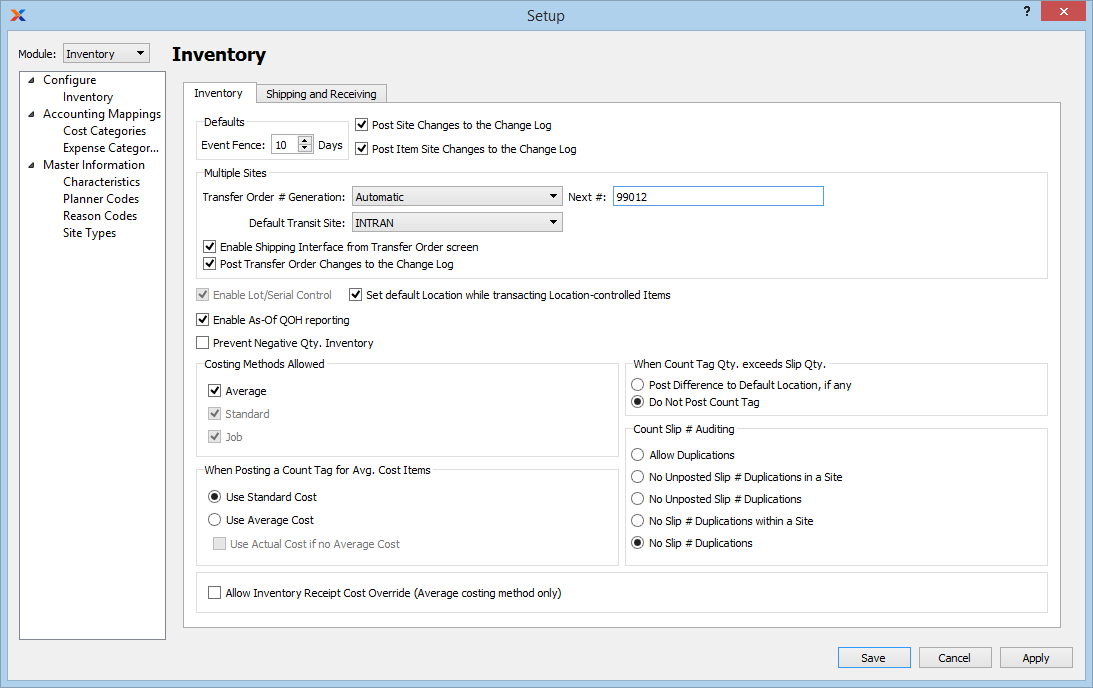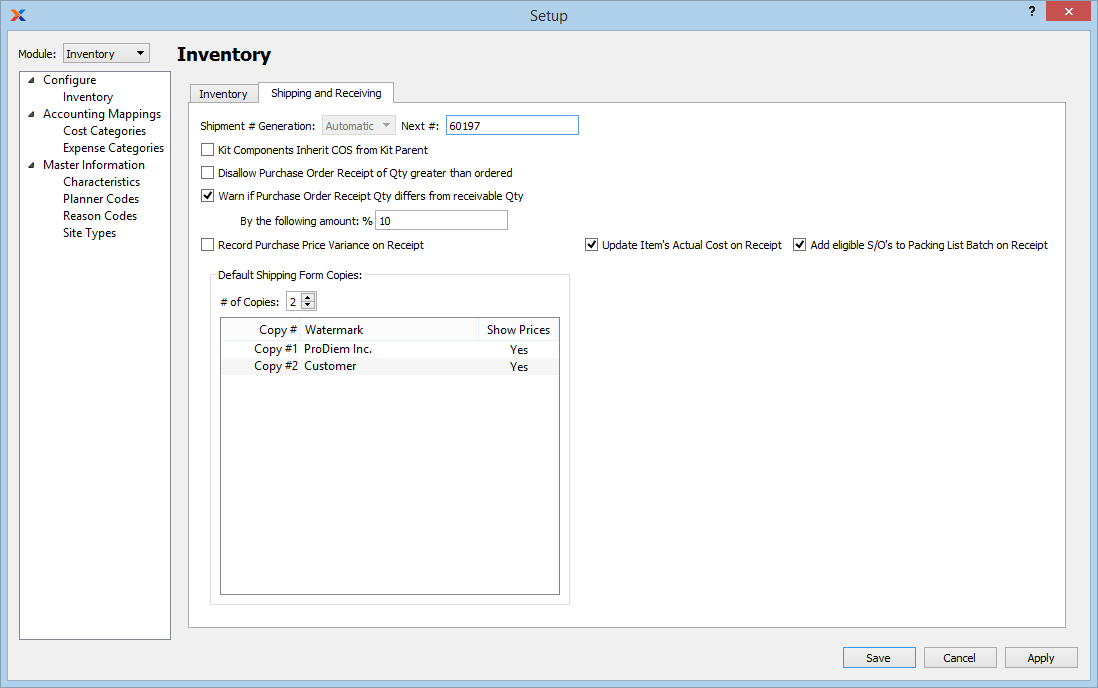
|
xTuple ERP Reference Guide |
To configure the Inventory module, select the "Configure Inventory" option. The following screen will appear

When configuring the Inventory module, you are presented with the following options:
Specify a default Event Fence:
Select a value between 0 and 999 using the arrow buttons located to the right of the field. Indicates the Event Fence value that will appear by default whenever a new Item Site is created. The value is measured in days.
Select to post to the Change Log any changes made to Item Site masters.
Select to post to the Change Log any changes made to Site masters.
Select to allow more than one Site to be entered in the system. If multiple Sites are not enabled, your system will be single Site only. Users will be prevented from creating more than one Site. If your system has multiple Sites defined, this option will be hidden.
If multiple Sites are enabled, select one of the available Transfer Order Number generation methods:
Transfer Order Numbers will be automatically incremented by 1 each time a new Transfer Order is created. These automatically-generated numbers may not be edited. They are read-only.
Transfer Order Numbers must be entered manually whenever you create a new Transfer Order.
Transfer Order Numbers will be automatically generated and incremented, as under the "Automatic" option described above. However, this option also allows you to manually override the Transfer Order Number at the time of Transfer Order creation.
The next sequentially available Transfer Order Number will display here. You may change the number—creating a new basis for the next Transfer Order Number—by typing the new number into this field. Any changes you make here will be reflected the next time a new Transfer Order is created.
If multiple Sites are enabled, specify the default Transit Site. The specified Site will be pre-selected by default whenever Transfer Orders are entered.
Select to enable Lot/Serial tracking capability in the system. If not selected, users will be prevented from creating Item Sites having either the Lot or Serial control method. Without the ability to create Lot/Serial Item Sites, the Lot/Serial tracking capability is disabled. If your system has Lot/Serial Item Sites defined, this option will be hidden.
Select to add an "As Of" date option to the Quantity on Hand report so that Inventory quantities and values can be determined for any given date. If not selected, Inventory values shown in the Quantity on Hand report will always reflect current values.
You should only enable As-Of QOH reporting during off hours, as this option may require extensive processing when it is run.
Select if you want to prevent Inventory transactions from causing the Quantity on Hand (QOH) for Item Sites to go negative. If not selected, Inventory transactions will be allowed to drive QOH negative.
Select if you want to allow users to set or change the default Location for Multiple Location Control (MLC) Items while in the process of conducting transactions involving MLC Items. If not selected, the default Location will have to be set or changed on the Item Site record for each Item.
Select any or all of the available methods to value inventory transactions for an Item Site. If any Item Sites exist for a particular Cost Method, that Cost Method is disabled to prevent unselecting.
Cost distributions for an Item Site is based on an average of all costs accumulated for the Item Site. The Quantity on Hand of Item Sites defined with this Cost Method will not be allowed to go negative.
Cost distributions for an Item Site is based on the Standard Cost posted for the Item.
Cost distributions for an Item Site is based on actual accumulation of costs on a Work Order. This Cost Method is used exclusively by Items with Type of "Job".
Specify how you want the Inventory value of Average Costed Items to be handled when posting Count Tags:
Select if you want to use the Item's Standard Cost when posting Count Tags. This option assumes you are maintaining Standard Costs for your Average Cost Items.
Select to use the Item's Average Cost when posting Count Tags. If no prior Average Cost exists, the Inventory value of a posted Count Tag will be $0.
Select to use the Item's Actual Cost if no Average Cost exists when posting Count Tags. This option provides an alternate method for valuing Inventory in the scenario where no prior Average Cost exists and also when Standard Costs are not in use.
Select one of the following options for handling discrepancies in count quantities:
Select to post excess Count Tag quantity to an Item's default location if the Item's Count Tag quantity exceeds its Count Slip quantity. Applies only if a default location has been defined for the Item. Default locations are defined for an Item in the Item Site record.
Select to prevent Count Tag quantity from being posted if it exceeds the Item's Count Slip quantity.
By default, the system allows only one unposted Count Tag per Item Site. If an unposted Count Tag already exists for an Item Site, then an additional duplicate Count Tag may not be added.
Select one of the following Count Slip number auditing methods:
Allows any Count Slip numbers to be used. Duplicate Count Slip numbers will also be allowed.
Prevents duplicate "Unposted" Count Slip numbers from existing within a given Site. However, duplicate "Unposted" Count Slip numbers may exist within multiple Sites.
Prevents duplicate "Unposted" Count Slip numbers from existing within multiple Sites.
Prevents duplicate Count Slip numbers from existing within a given Site. However, duplicate Count Slip numbers may exist within multiple Sites.
Prevents duplicate Count Slip Numbers from existing within multiple Sites.
Select this option to enable cost overrides for Average costed Items at the point when inventory is received. If not selected, any unposted or uninvoiced Receipts or PO Returns against Items previously received at an override cost value could be negatively affected.
To configure the Inventory Shipping and Receiving options, select the "Shipping and Receiving" tab. The following screen will appear:

When configuring Shipping and Receiving, you are presented with the following options:
By default, Shipment Numbers are generated automatically.
Enter the next Shipment Number to be used. The system assigns Shipment Numbers to Sales Order Line Item quantities when stock is issued to Shipping. All stock at Shipping for an individual Sales Order is assigned the same Shipment Number. If no stock is already at Shipping, then a new Shipment Number will be used.
Select if you want the components of Kit Items to inherit the same Cost of Sales (COS) Account used by the parent Kit Item. If not selected, the Kit components will use the COS Accounts defined in their respective Sales Account Assignments.
Select to ensure the maximum receiving quantity does not exceed the quantity ordered. If selected, the system will prevent users from receiving more Purchase Order Line Item quantity than the quantity ordered. Not selecting this option means users will be allowed to receive quantity in excess of the quantity ordered.
Select to generate a warning message if the entered quantity to receive does not match the quantity remaining to be received. The warning message will alert users that a difference exists. However, it will not prevent users from continuing.
Specify the percentage difference between Receipt quantity and receivable quantity which when reached should trigger a warning message.
If selected, Purchase Price Variances (PPV) will be recorded when Purchase Order Receipts are posted. This option applies to Standard costed Items. If not selected, then the default system behavior will be in effect—that is, PPV will be recorded when Vouchers are posted. It's technically possible (although unlikely) for PPV be recorded both at receipt and at Voucher time. This situation would occur if and only if the vouchered cost is different from the Purchase Order cost. For the PPV to be recorded twice, the following conditions would have to exist: First, there would have to be a difference between Purchase Order price and an Item's Standard Cost, and, second, there would also have to be a difference between the Purchase Order price and the vouchered price.
Indicate the number of Shipping Form copies you want to print by default:
Specify the number of copies you want to print. To add a Watermark or show/hide Prices on the printed Form, double-click on a copy line.
Select if you want the Actual Cost for a Purchase Order Item to be updated when that Item is received. This feature complements and does not replace the standard process, whereby a received Item's Actual Cost is updated at the point when a Voucher for that Item is posted.
Select if you want Sales Orders linked to Purchase Orders to be automatically added to the Packing List Batch when line items on the Purchase Order are received.